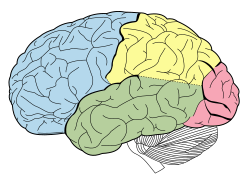Temporal lobe
| Temporal lobe | |
|---|---|
Lobes of the human brain (temporal lobe is shown in green) | |
| Identifiers | |
| Latin | lobus temporalis |
| MeSH | D013702 |
| NeuroNames | 125 |
| NeuroLex ID | birnlex_1160 |
| TA98 | A14.1.09.136 |
| TA2 | 5488 |
| FMA | 61825 |
| Anatomical terms of neuroanatomy] | |
The temporal lobe is one of the four
The temporal lobe is involved in processing sensory input into derived meanings for the appropriate retention of
Structure
The
Research has shown that lesions in the hippocampus of monkeys results in limited impairment of function, whereas extensive lesions that include the hippocampus and the medial temporal cortex result in severe impairment.[5]
Function
Visual memories
The temporal lobe communicates with the hippocampus and plays a key role in the formation of explicit long-term memory modulated by the amygdala.[4]: 349
Processing sensory input
- Auditory
- Adjacent areas in the superior, posterior, and lateral parts of the temporal lobes are involved in high-level auditory processing. The temporal lobe is involved in primary primary auditory cortex.[6] The primary auditory cortex receives sensory information from the ears and secondary areas process the information into meaningful units such as speech and words.[6] The superior temporal gyrus includes an area (within the lateral fissure) where auditory signals from the cochlea first reach the cerebral cortex and are processed by the primary auditory cortex in the left temporal lobe.[citation needed]
- Visual
- The areas associated with vision in the temporal lobe interpret the meaning of visual stimuli and establish ventral stream for visual processing are involved in object perception and recognition.[6]

Language recognition
The temporal lobe holds the
The functions of the left temporal lobe are not limited to low-level perception but extend to comprehension, naming, and verbal memory.[12]
New memories
The medial temporal lobes (near the
Clinical significance
Unilateral temporal lesion
- Contralateral homonymous upper quadrantanopia (sector anopsia)
- Complex hallucinations (smell, sound, vision, memory)
Dominant hemisphere
- Receptive aphasia
- Wernicke's aphasia
- Anomic aphasia
- Dyslexia
- Impaired verbal memory
- Word agnosia, word deafness
Non-dominant hemisphere
- Impaired non-verbal memory
- Impaired musical skills
Bitemporal lesions (additional features)
- Deafness
- Apathy (affective indifference)
- Impaired learning and memory
- Amnesia, Korsakoff syndrome, Klüver–Bucy syndrome
Damage
Individuals who suffer from medial temporal lobe damage have a difficult time recalling visual stimuli. This neurotransmission deficit is not due to lacking perception of visual stimuli, but rather to the inability to interpret what is perceived.[13] The most common symptom of inferior temporal lobe damage is visual agnosia, which involves impairment in the identification of familiar objects. Another less common type of inferior temporal lobe damage is prosopagnosia which is an impairment in the recognition of faces and distinction of unique individual facial features.[14]
Damage specifically to the anterior portion of the left temporal lobe can cause savant syndrome.[15]
Disorders
Temporal lobe epilepsy is a chronic neurological condition characterized by recurrent seizures; symptoms include a variety of sensory (visual, auditory, olfactory, and gustation) hallucinations, as well as an inability to process semantic and episodic memories.[18]
Schizophrenia is a severe psychotic disorder characterized by severe disorientation. Its most explicit symptom is the perception of external voices in the form of auditory hallucinations. The cause of such hallucinations has been attributed to deficits in the left temporal lobe, specifically within the primary auditory cortex.[19] Decreased gray matter, among other cellular deficits, contribute to spontaneous neural activity that affects the primary auditory cortex as if it were experiencing acoustic auditory input. The misrepresentation of speech in the auditory cortex results in the perception of external voices in the form of auditory hallucinations in schizophrenic patients.[20] Structural and functional MRI techniques have accounted for this neural activity by testing affected and non-affected individuals with external auditory stimuli.[19]
See also
References
- ^ ISBN 9781588903990.
- ISBN 9780865776982.
- ^ "Temporal Lobe". Langbrain. Rice University. Retrieved 2 January 2011.
- ^ a b c d e f g h Smith; Kosslyn (2007). Cognitive Psychology: Mind and Brain. New Jersey: Prentice Hall. pp. 21, 194–199, 349.
- PMID 15217334.
- ^ ISBN 9781429237192.[page needed]
- S2CID 6199399.
- ^ Richardson, Michael W. "Does the Brain Process Sign Language and Spoken Language Differently?". www.brainfacts.org. Retrieved 2020-12-14.
- PMID 17602162.
- ^ "Language Learning Through the Eye and Ear Webcast". clerccenter.gallaudet.edu. Archived from the original on 2020-12-05. Retrieved 2020-12-16.
- ^ Humphries, Tom; et al. (April 2012). "Language Acquisition for Deaf Children: Reducing the Harms of Zero Tolerance to the Use of Alternative Approaches". Harm Reduction Journal. 9(1):16 – via Research Gate.
- ^ Ruiz Mitjana, Laura (6 September 2019). "Lóbulo temporal: anatomía, funciones y características" [Temporal lobe: anatomy, functions and characteristics]. MedSalud (in Spanish).
- ^ Pertzov, Y., Miller, T. D., Gorgoraptis, N., Caine, D., Schott, J. M., Butler, C., & Husain, M. (2013). "Binding deficits in memory following medial temporal lobe damage in patients with voltage-gated potassium channel complex antibody-associated limbic encephalitis". Brain: A Journal of Neurology, 136(8), 2474–2485.
- ^ Mizuno, T., & Takeda, K. (2009). "The symptomatology of frontal and temporal lobe damages". Brain And Nerve = Shinkei Kenkyū No Shinpo, 61(11), 1209–1218.
- PMID 19528017.
- PMID 22411252.
- S2CID 23749655.
- ^ .
- .

